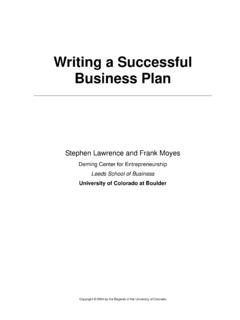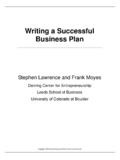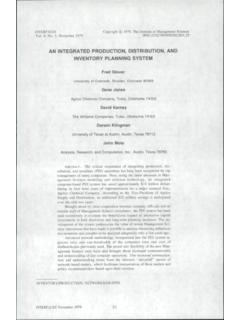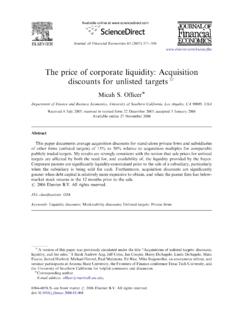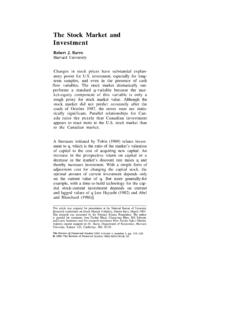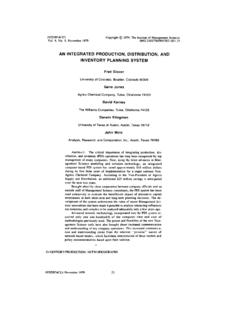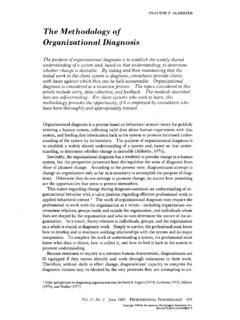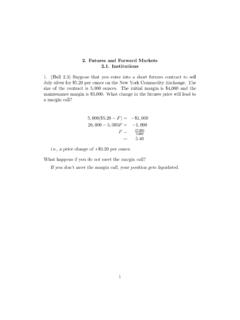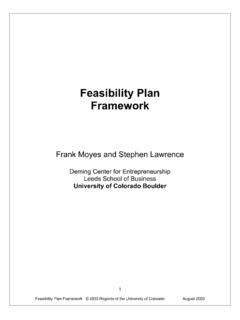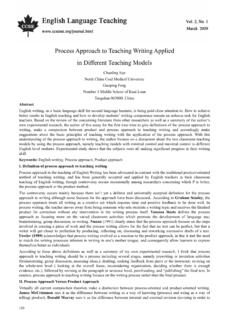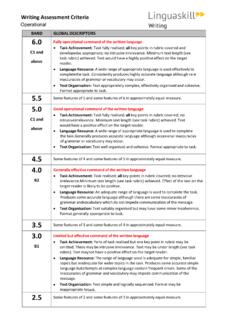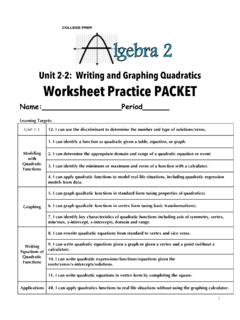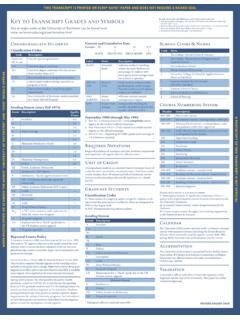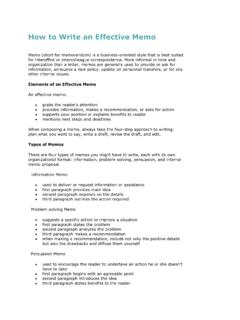Transcription of Elements of a Successful Business Plan
1 Writing a Successful Business Plan Stephen Lawrence and Frank Moyes Deming Center for Entrepreneurship Leeds School of Business University of Colorado at Boulder Copyright 2004 by the Regents of the University of Colorado Table of Contents Table of 1. Purpose of a Business Plan .. 2. Elements of a Successful Business Plan .. 3. Executive Summary .. 4. Company Overview .. 5. Product and Service .. 6. Market and Industry Analysis .. 8. Marketing Plan .. 14. Operations Plan .. 19. Development 22. Management Plan .. 23. Competitive Advantage .. 25. Financial 27. Funding .. 31. Appendices .. 34. 1. Writing a Successful Business Plan Copyright 2004 by The Regents of the University of Colorado Purpose of a Business Plan A Business plan describes the venture that you will create to exploit a concept. It has traditionally three primary functions: Action Plan A Business plan can help to move you to action.
2 You may have been thinking for years about starting a Business or engaging in some venture, but the process may seem too daunting, too large and too complicated. A Business plan will help you to pull apart the pieces of starting a Business and examine each piece by itself. So instead of one large problem, you have a sequence of smaller problems. And by solving the small problems, the large problem is automatically solved. So writing a Business plan can help to move you to action by breaking down a seemingly insurmountable task (starting a Business ) into many smaller, less intimidating tasks. Road Map Once you have started your Business , a Business plan can be an invaluable tool to help keep you on track and moving in the direction you want to go. In the hurley-burley of daily Business , it is very easy to lose sight of your objectives and goals -- a Business plan can help to keep you focused.
3 A Business plan can also serve to help others to understand your vision, including suppliers, customers, employees, friends, and family. Sales Tool A Business plan can serve as a sales tool. You will probably need outside financing to start your Business , and a Business plan is the tool you need to convince investors to come on board. You may also want and need concessions from suppliers or customers -- a Business plan can help you get them. Finally you may need to convince family members, or even yourself, that your ideas will bear fruit. A. well-written Business plan can serve to sell people close to you on the benefits of proceeding with your concept. Perhaps the most important reason to write a Business plan is that it requires you to engage in a rigorous, thoughtful and painful process that is essential before you start is a rigorous process before you start a viable venture.
4 It requires you to answer hard questions about your venture why is there a need for your product service? Who is you target market? How is your product/service different than your competitor's? What is your competitive advantage? How profitable is the Business and what are the cash flows? How should you fund the Business ? An added benefit is that by virtue of going through this process you will have established a sound basis for verbally communicating the attractiveness of your venture. To be able to describe your Business in a compelling manner and then to succinctly answer questions from investors is a critical skill. You can do this well only when you have made the venture a part of your soul. Writing a Successful Business Plan will help you do this. 2. Writing a Successful Business Plan Copyright 2004 by The Regents of the University of Colorado Elements of a Successful Business Plan Executive Summary (1 page).
5 Management (~1 page). Company Overview (~1 page) Company Organization Introduction Management Team Mission Statement History and Current Status Competitive Advantage (1 page). Objectives Financial Plan (~3 pages). Product and Service (~1 page) Financial Projections Features Key Assumptions Benefits Sources and Uses of Funds Proprietary Rights Business Risks Stage of Development Funding (1 page). Market and Industry Analysis (~3pages) Funding Requirements Market Size and Growth Funding Strategies Trends Sources and Uses of Funds Statement Target Market Offering Industry Structure Competitive Environment Appendices (15 pages max). Competition Required Opportunity Key financial assumptions 5 year Income Statement Marketing Plan (~4 pages) 5 year Balance Sheet Target Market Strategy 5 year Cash Flow Channel Monthly & Quarterly Cash Flow Positioning Statements Product/Service Strategy Financial Comps Pricing Strategy Resumes of founders and principals E-commerce Communication Strategy Optional Sales Strategy Customer surveys and results Revenue Model Operations layout Sample menus, web pages, adverts, etc.
6 Operations Plan (~2 pages) Anything else that will help to illuminate Operations Strategy and/or sell your plan Scope of Operations Ongoing Operations Development Plan (~1 page). Development Strategy 3. Writing a Successful Business Plan Copyright 2004 by The Regents of the University of Colorado Executive Summary The Executive Summary of a Business Plan is a one-page distillation of your entire plan, and often is the last section to be written. Despite the title, it is not written for executives, nor is it a summary of the plan. Its objective is to capture the reader's interest, so that they want to read the entire plan; even better to call you to arrange a meeting. It should be considered a chance to sell the reader on the Business opportunity. A first-time reader should be able to read the Summary by itself, and know what your plan is all about. The Summary should stand-alone and should not refer to other parts of your plan.
7 Remember, most readers will never get any further than your Executive Summary, so make it count! The Executive Summary should be a maximum of 2 pages. Ideally you should try to get it all on one page. This is very difficult to do, but being succinct has great benefits when trying to capture the attention of investors. The summary should address the following Elements of the plan: Concept Description Summarize the essence of your Business . Opportunity Why is this a good opportunity? What evidence do you have to support the demand? What is the size of your market? What are the critical trends and how will your company exploit them? What is the compelling need? Product/Service Describe the product or service. How is the product or service to be produced and delivered? Value Proposition Who is the target market? What are benefits to the target market? Marketing Strategy What are the key Elements of your marketing strategy?
8 Competitive Advantage Who is the competition? What is your competitive advantage? Management: Who is the management team and why will they make a success of the venture? Financial How large will the company become, what revenues will be achieved in year 3 or 4? When will the company breakeven? Funding How much funding is required? What is the offering? What is the exit strategy? 4. Writing a Successful Business Plan Copyright 2004 by The Regents of the University of Colorado Company Overview The Company Overview is a brief (one page) description of the company you have founded or want to found. How will it be organized? Will it be a sole proprietorship, partnership, or corporation? What are your ambitions for the company? Will it always be a small company, or do you want to grow it into an international giant? Upon reading this section, the reader should have a good idea of where you are and where you are going with your company.
9 Introduction In the introduction to the Company Overview, answer the following questions in a single paragraph: What is the name of our company? Does our company currently exist, or will it be forming? Where is it located? Where will we grow? How is our company organized ( , sole proprietorship, partnership, corporation)? Mission Statement Your mission statement is a short (one sentence to one short paragraph). inspirational statement of the vision and goals you have for your company. Too many mission statements are vacuous exercises in ambiguity , "employees are our most valuable asset". Be sure that your mission statement is succinct and content rich, and excites your readers. History and Current Status Briefly outline the history and current status of your company. Objectives In this subsection, spell out the objectives of your company in a single paragraph: Where are we going with our company?
10 What are our goals for the company (keep it small, grow it big, franchise it, etc.)? What is our exit strategy for ourselves and for our investors (sell to larger company, go public, buy out investors, etc.)? 5. Writing a Successful Business Plan Copyright 2004 by The Regents of the University of Colorado Product and Service Guidelines for Preparing This Section This section is a detailed description of the products and/or services you will be selling. You should not assume that the reader is familiar with your product/service, so be sure to explain and describe it carefully. Begin to sell your idea here by generating some excitement about your product/service. Be factual, but be enthusiastic. When readers have finished learning about your product or service, they should be primed for the marketing, operations and financial strategies of your venture. Sources of Information Technical specification and drawings Prototype Competitor product/service matrix Interviews - talk to experts in the marketplace, including buyers, suppliers, sales representatives, wholesalers, distributors, and retailers.
